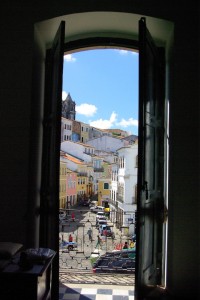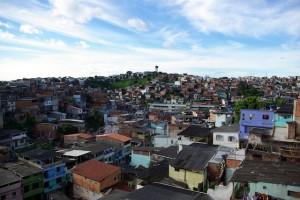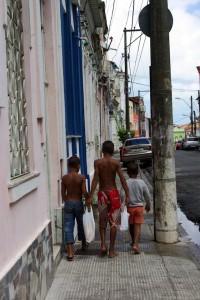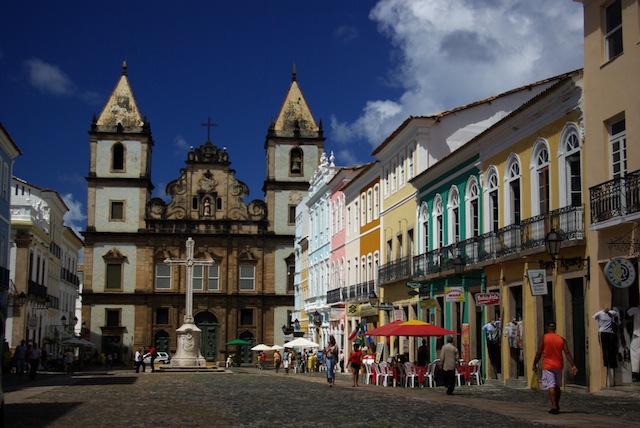By Ariana Chomitz
Vem, a Bahia te espera. A Bahia e um estado de espirito.
“Come, Bahia waits for you–Bahia is a state of mind,” wrote Brazilian author, Jorge Amado, in 1945, and visiting his home in the heart of Salvador today indeed evokes a sense of fantasy. Walking among the gelato-colored facades, slanting alleyways, and old stone plazas of Pelourinho, the historical core of the city, lulls visitors with its colonial-era charm. History, culture, and the arts have an established stronghold here, where pedestrians may, at any time, run up against live performances by a samba drum corps or a dance troupe in beautiful white clothing.

But Pelourinho is a state of mind, and not quite in the way that Amado meant. From a perch in the Upper City of Salvador, visitors to Pelourinho find their vista of the brilliant blue horizon underlined by the Lower City–a gritty, industrial pileup of buildings that extends along the coast and pushes inland. Unless you are a tourist or wealthy resident, this is likely the Salvador where you live or work. If your home in Salvador happens to be one of the large swaths of favelas, or complexly organized shantytowns, your life and livelihood go unrecognized by the officials…until the space you occupy becomes valuable.
Pelourinho’s pretty face today comes as a result of some extensive and sordid surgery 30 years ago. In the 1980’s, Salvador experienced a quick oil boom that relocated much of the urban activity from city center to coastline. All modernization efforts went to the new business areas by the ocean, leaving the urban centers to wither. Pelourinho fell into disrepair and, overlooked, absorbed much of the city’s poverty and crime. The marginalized populations that needed a home made Pelourinho theirs, and squatted alongside the bohemians, artists, and performers who moved in to take advantage of the cheap creative space. Some of these groups, like the batucada drum school, Olodum, would later rise to international fame.
Tourists and well-to-do Brazilians still avoided the area for fear of crime, but as the buzz built up around Pelourinho, the government initiated some programs to encourage the burgeoning art scene and to restore the buildings’ colonial beauty. None of the programs had much success until 1985, when UNESCO acknowledged Pelourinho as an area of Cultural World Heritage, pumping an enormous sum into Pelourinho’s revitalization over the next few years. The development project recovered old houses, rebuilt ruins, installed new businesses and preserved the traditional arts, but displaced hundreds of families in the process.
 In every other way, Pelourinho’s revival was a classic success, redefining the iconic Bahia and boosting the economy through cultural tourism, but the people who paid the true price of development were also cut out of the returns on the investment in Pelourinho’s glowing future. While the government rebuilt Pelourinho’s physical structure, they did nothing to address the underlying structural violence in Salvador’s social and political landscape. The displaced families viewed the development as a poorly disguised state takeover, which forcibly removed longtime residents from their homes and paid them inadequately, if at all. They found themselves with appallingly little to afford a transition and no clear options for moving forward, as the developers had not included any plans for resettlement.
In every other way, Pelourinho’s revival was a classic success, redefining the iconic Bahia and boosting the economy through cultural tourism, but the people who paid the true price of development were also cut out of the returns on the investment in Pelourinho’s glowing future. While the government rebuilt Pelourinho’s physical structure, they did nothing to address the underlying structural violence in Salvador’s social and political landscape. The displaced families viewed the development as a poorly disguised state takeover, which forcibly removed longtime residents from their homes and paid them inadequately, if at all. They found themselves with appallingly little to afford a transition and no clear options for moving forward, as the developers had not included any plans for resettlement.
Today, the embedded tensions of historic poverty, discrimination and negligent authority are flaring up. Even with the enviable economic growth, Salvador has recently made headlines as Brazil’s new murder capital. Infrastructure and social services are crumbling even as local and national government gear up to prepare for the World Cup and the Olympics. Pelourinho’s story parallels the renovations throughout the country, in reports of more development-induced displacement and protests against the building of more stadiums while neglecting hospitals and schools.
In Rio, the soon-to-be hub for celebrations for the upcoming international events, politicians pay lip service to social ideals while carrying out a $4 billion port redevelopment plan that will “clean up” the poor but aesthetically potent neighborhoods at the historic heart of the city. As strings of recent protests suggest, these plans are not the ones that the city residents actually need. And, as in Pelourinho, the resettlement plans, practical long-term benefits, and improvements to city services are only hazy outlines, even as developers break ground for fantastic and futuristic structures.
 Brazil’s marginalized populations are angry and frustrated with a government and its called upon developers who are creating sanitized versions of the country and its culture for international consumption at the sake of deprioritizing the health, safety and happiness of poor communities. Like Pelourinho, Brazil will undoubtedly enjoy sustained economic growth from the tourism, new jobs, and city improvements that World Cup development brings.
Brazil’s marginalized populations are angry and frustrated with a government and its called upon developers who are creating sanitized versions of the country and its culture for international consumption at the sake of deprioritizing the health, safety and happiness of poor communities. Like Pelourinho, Brazil will undoubtedly enjoy sustained economic growth from the tourism, new jobs, and city improvements that World Cup development brings.
However, history shows that it is too optimistic to trust in trickle-down benefits of such development. Brazil needs a sincere and attainable strategy to care for its people now, and not in the promised future. Affected communities–those displaced by new buildings or struggling in poverty while tourist infrastructure blossoms on the horizon–must receive more than the price of their disrupted lives. They should be overcompensated, if anything, as empowered owners of Brazil’s future. The Brazilian government’s official slogan used to be “Brasil—Um Pais Para Todos.” Brazil, a Country for Everyone. If Brazil is indeed a state of mind, we should imagine it as a place that is equally beautiful to everyone, and not just the privileged few.
 About the Writer
About the Writer
Ariana Chomitz is a writer, photographer, and traveler from Washington, DC. She graduated from Kenyon College, where she received a B.A. in Anthropology and experimented with her passion for digital storytelling in both academic research and personal expression. A strong proponent of experiential education, Ariana spent her gap year in India, studied abroad in Indonesia and Brazil, and currently works for a high school study abroad organization as a program leader and social media creator. She believes that travel should challenge, that art should delight and inform, that people will surprise you, and that bubble baths should cap off the best and the worst days.



